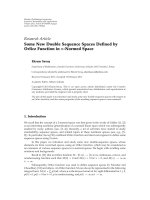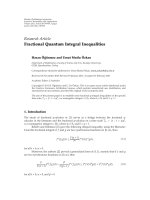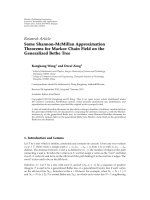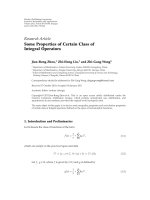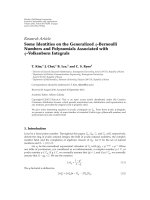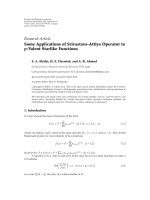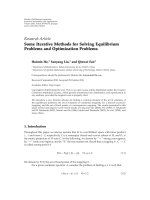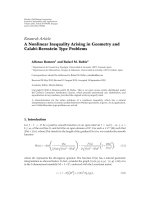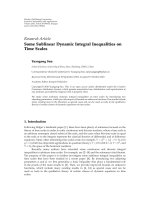Báo cáo hóa học: "Research Article Some Nonlinear Integral Inequalities on Time Scales" pptx
Bạn đang xem bản rút gọn của tài liệu. Xem và tải ngay bản đầy đủ của tài liệu tại đây (548.75 KB, 15 trang )
Hindawi Publishing Corporation
Journal of Inequalities and Applications
Volume 2007, Article ID 70465, 15 pages
doi:10.1155/2007/70465
Research Article
Some Nonlinear Integral Inequalities on Time Scales
Wei Nian Li and Weihong Sheng
Received 28 August 2007; Accepted 6 November 2007
Recommended by Alberto Cabada
The pur pose of this paper is to investigate some nonlinear integral inequalities on time
scales. Our results unify and extend some continuous inequalities and their correspond-
ing discrete analogues. The theoretical results are illustrated by a simple example at the
end of this paper.
Copyright © 2007 W. N. Li and W. Sheng. This is an open access article distributed under
the Creative Commons Attribution License, which permits unrestricted use, distribution,
and reproduction in any medium, provided the original work is properly cited.
1. Introduction
The theory of t ime scales was introduced by Hilger [1] in his Ph.D. thesis in 1988 in order
to unify continuous and discrete analysis. Recently, many authors have extended some
fundamental integral inequalities used in the theory of differential and integral equations
on time scales. For example, we refer the reader to the literatures [2–8] and the references
cited therein.
In this paper, we investigate some nonlinear integral inequalities on time scales, which
unify and extend some inequalities established by Pachpatte in [9]. The obtained inequal-
ities can be used as important tools in the study of certain properties of dynamic equa-
tionsontimescales.
2. Preliminaries on time scales
We first briefly introduce the time scales calculus, which can be found in [4, 5].
In what follows,
R denotes the set of real numbers, Z denotes the set of integers, N
0
de-
notes the set of nonnegative integers,
C denotes the set of complex numbers, and C(M,S)
denotes the class of all continuous functions defined on set M with range in the set S.
2 Journal of Inequalities and Applications
We use the usual conventions that empty sums and products are taken to be 0 and 1
respectively.
A time scale
T is an arbitrary nonempty closed subset of R.Theforward jump operator
σ on
T is defined by
σ(t):
= inf {s ∈ T : s>t}∈T ∀t ∈ T. (2.1)
In this definition we put inf
∅ = supT,where∅ is the empty set. If σ(t) >t,thenwesay
that t is right-s cattered.Ifσ(t)
= t and t<supT,thenwesaythatt is right-dense.The
backward jump operator, left-scattered and left-dense points are defined in a similar way.
The graininess μ :
T→[0,∞)isdefinedbyμ(t):= σ(t) − t. The set T
κ
is derived from T as
follows: If
T has a left–scattered maximum m,thenT
κ
=
T −{
m}; otherwise, T
κ
=
T
.
Remark 2.1. Clearly, we see that σ(t)
= t if T
=
R and σ(t) = t +1ifT
=
Z.
For f :
T→R and t ≥ t
0
, t ∈ T
κ
,wedefine f
(t) to be the number (provided it exists)
such that given any ε>0, there is a neighborhood U of t with
f (σ(t)) − f (s)
−
f
(t)
σ(t) −s
≤
ε
σ(t) −s
∀
s ∈ U. (2.2)
We call f
(t)thedelta derivative of f at t.
Remark 2.2. f
is the usual derivative f
if T
=
R and the usual forward difference Δ f
(defined by Δ f (t)
= f (t +1)− f (t)) if T
=
Z.
We say that f :
T→R is rd–continuous provided f is continuous at each right–dense
point of
T and has a finite left–sided limit at each left–dense point of T. As usual, the set of
rd–continuous functions is denoted by C
rd
. A function F : T→R is called an antiderivative
of f :
T→R provided F
(t) = f (t)holdsforallt ∈ T
κ
. In this case we define the Cauchy
integral of f by
b
a
f (t)Δt = F(b) − F(a)fora,b ∈ T. (2.3)
We say that p :
T→R is regressive provided 1 + μ(t)p(t)=0forallt ∈ T. We denote by
the set of all regressive and rd–continuous functions. We define the set of all positively
regressive functions by
+
={p ∈ :1+μ(t)p(t) > 0forallt∈ T }.
For h>0, we define the cylinder transformation ξ
h
: C
h
→Z
h
by
ξ
h
(z) =
1
h
Log(1 + zh), (2.4)
where Log is the principal logarithm function, and
C
h
=
z ∈ C : z=−
1
h
, Z
h=
z ∈ C : −
π
h
< Im(z)
≤
π
h
. (2.5)
For h
= 0, we define ξ
0
(z) = z for all z ∈ C.
If p
∈ , then we define the exponential function by
e
p
(t,s) = exp
t
s
ξ
μ(τ)
p(τ)
Δτ
for s,t ∈ T. (2.6)
W. N. Li and W. Sheng 3
Theorem 2.3. If p
∈ and fix t
0
∈ T, then the exponential function e
p
(·,t
0
) is for the
unique solution of the initial value problem
x
Δ
= p(t)x, x
t
0
=
1 on T. (2.7)
Theorem 2.4. If p
∈ , then
(i) e
p
(t,t) ≡ 1 and e
0
(t,s) ≡ 1;
(ii) e
p
(σ(t),s) = (1 + μ(t)p(t))e
p
(t,s);
(iii) if p
∈
+
, then e
p
(t,t
0
) > 0 for all t ∈ T.
Remark 2.5. Clearly, the exponential function is given by
e
p
(t,s) = e
t
s
p(τ)dτ
, e
α
(t,s) = e
α(t−s)
, e
α
(t,0) = e
αt
(2.8)
for s,t
∈ R,whereα ∈ R is a constant and p : R→R is a continuous function if T
=
R,and
the exponential function is given by
e
p
(t,s) =
t−1
τ=s
1+p(τ)
, e
α
(t,s) = (1 + α)
t−s
, e
α
(t,0) = (1 + α)
t
(2.9)
for s,t
∈ Z with s<t,whereα=−1 is a constant and p : Z→R is a sequence satisfying
p(t)
=−1forallt ∈ Z if T
=
Z.
Theorem 2.6. If p
∈ and a,b,c ∈ T, the n
b
a
p(t)e
p
c,σ(t)
Δt = e
p
(c,a) − e
p
(c,b). (2.10)
Theorem 2.7. Let t
0
∈ T
κ
and w : T × T
κ
→R be continuous at (t,t), t ∈ T
κ
with t>t
0
.As-
sume that w
Δ
1
(t,·)t is rd-continuous on [t
0
,σ(t)].Ifforanyε>0, there exists a neighborhood
Uof t, independent of τ
∈ [t
0
,σ(t)], such that
w
σ(t),τ
−
w(s,τ) − w
Δ
1
(t,τ)
σ(t) − s
≤
ε
σ(t) − s
∀
s ∈ U, (2.11)
where w
Δ
1
denotes the derivative of w with respect to the first variable, then
υ(t):
=
t
t
0
w(t,τ)Δτ (2.12)
implies
υ
Δ
(t) =
t
t
0
w
Δ
1
(t,τ)Δτ + w
σ(t),t
. (2.13)
The following theorem, which can be found in [4, Theorem 6.1, p.253], is a founda-
tional result in dynamic inequalities.
Theorem 2.8 (Comparison theorem). Suppose u,b
∈ C
rd
, a ∈
+
. Then
u
Δ
(t) ≤ a(t)u(t)+b(t), t ≥ t
0
, t ∈ T
κ
(2.14)
4 Journal of Inequalities and Applications
implies
u(t)
≤ u
t
0
e
a
t,t
0
+
t
t
0
e
a
t,σ(τ)
b(τ)Δτ, t ≥ t
0
, t ∈ T
κ
. (2.15)
3. Main results
In this section, we deal with integ ral inequalities on time scales. Throughout this section,
we always assume that p
≥ q>0, p and q are real constants, and t ≥ t
0
, t
0
∈ T
κ
.
The following lemma is useful in our main results.
Lemma 3.1. Let a
≥ 0. Then
a
q/p
≤
q
p
K
(q−p)/p
a +
p
− q
p
K
q/p
for any K>0. (3.1)
Proof. If a
= 0, then we easily see that the inequality (3.1) holds. Thus we only prove that
the inequality (3.1) holds in the case of a>0.
Letting
f (K)
=
q
p
K
(q−p)/p
a +
p
− q
p
K
q/p
, K>0, (3.2)
we have
f
(K) =
q(p − q)
p
2
K
(q−2p)/p
(K − a). (3.3)
It is easy to see that
f
(K) ≥ 0, K>a,
f
(K) = 0, K = a,
f
(K) ≤ 0, 0 <K<a.
(3.4)
Therefore,
f (K)
≥ f (a) = a
q/p
. (3.5)
The proof of Lemma 3.1 is complete.
Theorem 3.2. Assume that u,a,b,g,h ∈ C
rd
, u(t), a(t), b(t), g(t),andh(t) are nonnegative.
Then
u
p
(t) ≤ a(t)+b(t)
t
t
0
g(τ)u
p
(τ)+h(τ)u
q
(τ)
Δτ, t ∈ T
κ
, (3.6)
implies
u(t)
≤
a(t)+b(t)
t
t
0
a(τ)g(τ)+h(τ)
K(p − q)+qa(τ)
pK
(p−q)/p
×
e
F
t,σ(τ)
Δτ
1/p
for any K>0, t ∈ T
κ
,
(3.7)
W. N. Li and W. Sheng 5
where
F(t)
= b(t)
g(t)+
qh(t)
pK
(p−q)/p
. (3.8)
Proof. Define a function z(t)by
z(t)
=
t
t
0
g(τ)u
p
(τ)+h(τ)u
q
(τ)
Δτ, t ∈ T
κ
. (3.9)
Then z(t
0
) = 0and(3.6) can be restated as
u
p
(t) ≤ a(t)+b(t)z(t), t ∈ T
κ
. (3.10)
Using Lemma 3.1,from(3.10), for any K>0, we easily obtain
u
q
(t)≤
a(t)+b(t)z(t)
q/p
≤
K(p − q)+qa(t)
pK
(p−q)/p
+
qb(t)z(t)
pK
(p−q)/p
.
(3.11)
Combining (3.9)–(3.11), we get
z
Δ
(t) = g(t)u
p
(t)+h(t)u
q
(t)
≤ g(t)
a(t)+b(t)z(t)
+ h(t)
K(p − q)+qa(t)
pK
(p−q)/p
+
qb(t)z(t)
pK
(p−q)/p
=
a(t)g(t)+
K(p
− q)+qa(t)
pK
(p−q)/p
h(t)
+ F(t)z(t), t ∈ T
κ
,
(3.12)
where F(t)isdefinedasin(3.8).
It is easy to see that F(t)
∈
+
. Therefore, using Theorem 2.8 and noting z(t
0
) = 0,
from (3.12)weobtain
z(t)
≤
t
t
0
a(τ)g(τ)+
K(p
− q)+qa(τ)
pK
(p−q)/p
h(τ)
e
F
t,σ(τ)
Δτ, t ∈ T
κ
. (3.13)
Clearly, the desired inequality (3.7)followsfrom(3.10)and(3.13). This completes the
proof of Theorem 3.2.
Corollary 3.3. Let T
=
R and assume that u(t),a(t),b(t),g(t),h(t) ∈ C(R
+
,R
+
). Then the
inequality
u
p
(t) ≤ a(t)+b(t)
t
0
g(s)u
p
(s)+h(s)u
q
(s)
ds, t ∈ R
+
, (3.14)
6 Journal of Inequalities and Applications
implies
u(t)
≤
a(t)+b(t)
t
0
a(τ)g(τ)+h(τ)
K(p − q)+qa(τ)
pK
(p−q)/p
×
exp
t
τ
F(s)ds
dτ
1/p
for any K>0, t ∈ R
+
,
(3.15)
where F(t) is defined as in Theorem 3.2.
Corollary 3.4. Let
T
=
Z andassumethatu(t), a(t), b(t), g(t),andh(t) are nonnegative
functions defined for t
∈ N
0
. Then the inequality
u
p
(t) ≤ a(t)+b(t)
t−1
s=0
g(s)u
p
(s)+h(s)u
q
(s)
, t ∈ N
0
, (3.16)
implies
u(t)
≤
a(t)+b(t)
t−1
τ=0
a(τ)g(τ)+h(τ)
K(p − q)+qa(τ)
pK
(p−q)/p
×
t−1
s=τ+1
1+F(s)
1/p
for any K>0, t ∈ N
0
,
(3.17)
where F(t) is defined as in Theorem 3.2.
Remark 3.5. Letting p>1, K
= q = 1 in Corollaries 3.3 and 3.4, we easily obtain Theorem
1(a
1
)andTheorem3(c
1
) established by Pachpatte [9], respectively.
Corollary 3.6. Assume that u,h
∈ C
rd
, u(t) and h(t) are nonnegative. If β ≥ 0 is a real
constant, then
u
p
(t) ≤ β +
t
t
0
h(τ)u
q
(τ)Δτ, t ∈ T
κ
, (3.18)
implies
u(t)
≤
1
q
(K(p − q)+qβ)e
F
(t,t
0
) − K(p − q)
1/p
for any K>0, t ∈ T
κ
, (3.19)
where
F(t) =
qh(t)
pK
(p−q)/p
. (3.20)
W. N. Li and W. Sheng 7
Proof. Using Theorem 3.2,itfollowsfrom(3.18)that
u(t)
≤
β +
t
t
0
h(τ)
K(p
− q)+qβ
pK
(p−q)/p
e
F
(t,σ(τ))Δτ
1/p
=
β +
K(p − q)
q
+ β
t
t
0
F(τ)e
F
(t,σ(τ))Δτ
1/p
=
β +
K(p − q)
q
+ β
e
F
(t,t
0
) − e
F
(t,t)
1/p
=
β +
K(p − q)
q
+ β
e
F
(t,t
0
) −
K(p − q)
q
− β
1/p
=
1
q
(K(p − q)+qβ)e
F
(t,t
0
) − K(p − q)
1/p
for any K>0, t ∈ T
κ
,
(3.21)
where the second equation holds because of Theorem 2.6, and the third equation holds
because of Theorem 2.4(i). This completes the proof.
Theorem 3.7. Assume that u,a,b,g,h
i
∈ C
rd
, u(t), a(t), b(t), g(t),andh
i
(t) are nonnega-
tive, and i
= 1,2, ,n. If there exists a sequence of positive real numbers q
1
,q
2
, ,q
n
such
that p
≥ q
i
> 0, i = 1,2, ,n, then
u
p
(t) ≤ a(t)+b(t)
t
t
0
g(τ)u
p
(τ)
n
i=1
h
i
(τ)u
q
i
(τ)
Δτ, t ∈ T
κ
,
(3.22)
implies
u(t)
≤
a(t)+b(t)
t
t
0
a(τ)g(τ)+
n
i=1
h
i
(τ)
K(p − q
i
)+q
i
a(τ)
pK
(p−q
i
)/p
×
e
F
∗
t,σ(τ)
Δτ
1/p
for any K>0, t ∈ T
κ
,
(3.23)
where
F
∗
(t) = b(t)
g(t)+
n
i=1
q
i
h
i
(t)
pK
(p−q
i
)/p
. (3.24)
Proof. Define z(t)by
z(t)
=
t
t
0
g(τ)u
p
(τ)+
n
i=1
h
i
(τ)u
q
i
(τ)
Δτ, t ∈ T
κ
. (3.25)
8 Journal of Inequalities and Applications
Then z(t
0
) = 0, and as in the proof of Theorem 3.2,wehave(3.10)and
u
q
i
(t) ≤
K(p − q
i
)+q
i
a(t)
pK
(p−q
i
)/p
+
q
i
b(t)z(t)
pK
(p−q
i
)/p
for any K>0, i = 1, 2, ,n. (3.26)
Therefore,
z
Δ
(t) = g(t)u
p
(t)+
n
i=1
h
i
(t)u
q
i
(t)
≤ g(t)
a(t)+b(t)z(t)
+
n
i=1
h
i
(t)
K
p − q
i
+ q
i
a(t)
pK
(p−q
i
)/p
+
q
i
b(t)z(t)
pK
(p−q
i
)/p
=
a(t)g(t)+
n
i=1
h
i
(t)
K
p − q
i
+ q
i
a(t)
pK
(p−q
i
)/p
+ F
∗
(t)z(t), t ∈ T
κ
,
(3.27)
where F
∗
(t)isdefinedasin(3.24).
The remainder of the proof is similar to that of Theorem 3.2 andweomitithere.
Theorem 3.8. Assume that u,a,b,g,h ∈ C
rd
, u(t), a(t), b(t), g(t),andh(t) are nonnegative,
and w(t,s) is defined as in Theorem 2.7 such that w(t,s)
≥ 0 and w
Δ
1
(t,s) ≥ 0 for t,s ∈ Twith
s
≤ t.Ifforanyε>0, there exists a neighborhood Uof t, independent of τ ∈ [t
0
,σ(t)],such
that for all s
∈ U,
w
σ(t),τ
−
w(s,τ) − w
Δ
1
(t,τ)(σ(t) − s)
g(τ)u
p
(τ)+h(τ)u
q
(τ)
≤
ε
σ(t) − s
,
(3.28)
then
u
p
(t) ≤ a(t)+b(t)
t
t
0
w(t,τ)
g(τ)u
p
(τ)+h(τ)u
q
(τ)
Δτ, t ∈ T
κ
, (3.29)
implies
u(t)
≤
a(t)+b(t)
t
t
0
e
A
(t,σ(τ))B(τ)Δτ
1/p
for any K>0, t ∈ T
κ
, (3.30)
where
A(t)
= w
σ(t),t
b(t)
g(t)+
qh(t)
pK
(p−q)/p
+
t
t
0
w
Δ
1
(t,τ)b(τ)
g(τ)+
qh(τ)
pK
(p−q)/p
Δτ,
B(t)
= w(σ(t),t)
a(t)g(t)+h(t)
K(p − q)+qa(t)
pK
(p−q)/p
+
t
t
0
w
Δ
1
(t,τ)
a(τ)g(τ)+h(τ)
K(p − q)+qa(τ)
pK
(p−q)/p
Δτ, t ∈ T
κ
.
(3.31)
W. N. Li and W. Sheng 9
Proof. Define a function z(t)by
z(t)
=
t
t
0
k(t,τ)Δτ, t ∈ T
κ
, (3.32)
where
k(t,τ)
= w(t,τ)
g(τ)u
p
(τ)+h(τ)u
q
(τ)
, t ∈ T
κ
. (3.33)
Then z(t
0
) = 0. As in the proof of Theorem 3.2, we easily obtain (3.10)and(3.11).
It follows from (3.33)that
k(σ(t),t)
= w(σ(t),t)
g(t)u
p
(t)+h(t)u
q
(t)
, (3.34)
k
Δ
1
(t,τ) = w
Δ
1
(t,τ)
g(τ)u
p
(τ)+h(τ)u
q
(τ)
. (3.35)
Therefore, noting the condition (3.28), using Theorem 2.7, and combining (3.32)–(3.35),
(3.10), and (3.11), we have
z
Δ
(t) = k(σ(t),t)+
t
t
0
k
Δ
1
(t,τ)Δτ
= w(σ(t),t)
g(t)u
p
(t)+h(t)u
q
(t)
+
t
t
0
w
Δ
1
(t,τ)
g(τ)u
p
(τ)+h(τ)u
q
(τ)
Δτ
≤ w(σ(t),t)
a(t)g(t)+h(t)
K(p − q)+qa(t)
pK
(p−q)/p
+ b(t)
g(t)+
qh(t)
pK
(p−q)/p
z(t)
+
t
t
0
w
Δ
1
(t,τ)
a(τ)g(τ)+h(τ)
K(p − q)+qa(τ)
pK
(p−q)/p
+ b(τ)
g(τ)+
qh(τ)
pK
(p−q)/p
z(τ)
Δτ
≤
w(σ(t),t)b(t)
g(t)+
qh(t)
pK
(p−q)/p
+
t
t
0
w
Δ
1
(t,τ)b(τ)
g(τ)+
qh(τ)
pK
(p−q)/p
Δτ
z(t)
+ w(σ(t), t)
a(t)g(t)+h(t)
K(p − q)+qa(t)
pK
(p−q)/p
+
t
t
0
w
Δ
1
(t,τ)
a(τ)g(τ)+h(τ)
K(p − q)+qa(τ)
pK
(p−q)/p
Δτ
= A(t)z(t)+B(t), t ∈ T
κ
.
(3.36)
Therefore, using Theorem 2.8 and noting z(t
0
) = 0, we get
z(t)
≤
t
t
0
e
A
(t,σ(τ))B(τ)Δτ, t ∈ T
κ
. (3.37)
It is easy to see that the desired inequality (3.30)followsfrom(3.10)and(3.37). The
proof of Theorem 3.8 is complete.
10 Journal of Inequalities and Applications
Corollary 3.9. Let
T
=
R and assume that u(t),a(t),b(t),g(t),h(t) ∈ C(R
+
,R
+
).Ifw(t,s)
and its partial derivative (∂/∂t) w(t,s) are real-valued nonnegative continuous functions for
t,s
∈ R
+
with s ≤ t, then the inequality
u
p
(t) ≤ a(t)+b(t)
t
0
w(t,τ)
g(τ)u
p
(τ)+h(τ)u
q
(τ)
dτ, t ∈ R
+
, (3.38)
implies
u(t)
≤
a(t)+b(t)
t
0
exp
t
τ
A(s)ds
B(τ)dτ
1/p
for any K>0, t ∈ R
+
, (3.39)
where
A(t) = w(t,t)b(t)
g(t)+
qh(t)
pK
(p−q)/p
+
t
0
∂w(t,τ)
∂t
b(τ)
g(τ)+
qh(τ)
pK
(p−q)/p
dτ,
B(t) = w(t,t)
a(t)g(t)+h(t)
K(p − q)+qa(t)
pK
(p−q)/p
+
t
0
∂w(t,τ)
∂t
a(τ)g(τ)+h(τ)
K(p − q)+qa(τ)
pK
(p−q)/p
dτ, t ∈ R
+
.
(3.40)
Corollary 3.10. Let
T
=
Z and assume that u(t), a(t), b(t), g(t),andh(t) are nonnegative
functions defined for t
∈ N
0
.Ifw(t,s)and Δ
1
w(t,s) are real-valued nonnegative functions for
t,s
∈ N
0
with s ≤ t, then the inequality
u
p
(t) ≤ a(t)+b(t)
t−1
τ=0
w(t,τ)
g(τ)u
p
(τ)+h(τ)u
q
(τ)
, t ∈ N
0
, (3.41)
implies
u(t)
≤
a(t)+b(t)
t−1
τ=0
B(τ)
t−1
s=τ+1
1+
A(s)
1/p
for any K>0, t ∈ N
0
, (3.42)
where Δ
1
w(t,s) = w( t +1,s) − w(t,s) for t,s ∈ N
0
with s ≤ t,
A(t) = w(t +1,t)b( t)
g(t)+
qh(t)
pK
(p−q)/p
+
t−1
τ=0
Δ
1
w(t,τ)b(τ)
g(τ)+
qh(τ)
pK
(p−q)/p
,
B(t) = w(t +1,t)
a(t)g(t)+h(t)
K(p − q)+qa(t)
pK
(p−q)/p
+
t−1
τ=0
Δ
1
w(t,τ)
a(τ)g(τ)+h(τ)
K(p − q)+qa(τ)
pK
(p−q)/p
, t ∈ N
0
.
(3.43)
Remark 3.11. Let p>1, K
= q = 1. Then the inequality established in Corollary 3.9 re-
duces to the inequality established by Pachpatte in [9,Theorem1(a
3
)], and the inequality
established in Corollary 3.10 reduces to the inequality in [9,Theorem3(c
3
)].
W. N. Li and W. Sheng 11
Corollary 3.12. Suppose that α
≥ 0 is a constant, u(t) and w(t, s) aredefinedasin
Theorem 3.8.Ifforanyε>0, there exists a neighborhood U of t, independent of τ
∈[t
0
,σ(t)],
such that for all s
∈ U,
u
q
(τ)
w
σ(t),τ
−
w(s,τ) − w
Δ
1
(t,τ)
σ(t) − s
≤
ε
σ(t) − s
, (3.44)
then
u
p
(t) ≤ α +
t
t
0
w(t,τ)u
q
(τ)Δτ, t ∈ T
κ
, (3.45)
implies
u(t)
≤
1
q
(K(p − q)+qα)e
A
(t,t
0
) − K(p − q)
1/p
for any K>0, t ∈ T
κ
, (3.46)
where
A(t) =
q
pK
(p−q)/p
w(σ(t),t)+
t
t
0
w
Δ
1
(t,τ)Δτ
, t ∈ T
κ
. (3.47)
Proof. Letting b(t)
= 1, g(t) = 0andh(t) = 1inTheorem 3.8,weobtain
A(t)
=
q
pK
(p−q)/p
w
σ(t),t
+
t
t
0
w
Δ
1
(t,τ)Δτ
:=
A(t), t ∈ T
κ
,
B(t)
=
K(p − q)+qα
pK
(p−q)/p
w
σ(t),t
+
t
t
0
w
Δ
1
(t,τ)Δτ
=
K(p − q)+qα
q
A(t), t ∈ T
κ
.
(3.48)
Therefore, by Theorem 3.8, noting (3.48), we easily obtain
u(t)
≤
α +
t
t
0
e
A
t,σ(τ
)B(τ)Δτ
1/p
=
α +
t
t
0
e
A
t,σ(τ)
K(p − q)+qα
q
A(τ)Δτ
1/p
=
α +
K(p
− q)+qα
q
t
t
0
e
A
t,σ(τ)
A(τ)Δτ
1/p
=
α +
K(p
− q)+qα
q
e
A
t,t
0
−
e
A
(t,t)
1/p
=
K(p − q)+qα
q
e
A
t,t
0
) −
K(p − q
q
1/p
for any K>0, t ∈ T
κ
.
(3.49)
The proof of Corollary 3.12 is complete.
By investigating the proof procedure of Theorem 3.8 carefully, we easily obtain the
following result.
12 Journal of Inequalities and Applications
Theorem 3.13. Assume that u,a,b,g,h
i
∈ C
rd
, u(t), a(t), b(t), g(t),andh
i
(t) are nonneg-
ative, i
= 1,2, ,n, and there exists a sequence of positive real numbers q
1
,q
2
, ,q
n
such
that p
≥ q
i
> 0, i = 1,2, ,n. Let w(t,s) be defined as in Theorem 2.7 such that w(t,s) ≥ 0
and w
Δ
1
(t,s) ≥ 0 for t,s ∈ T with s ≤ t.Ifforanyε>0, there exists a neighborhood U of t,
independent of τ
∈ [t
0
,σ(t)], such that for all s ∈ U,
w
σ(t),τ
−
w(s,τ) − w
Δ
1
(t,τ)
σ(t) − s
g(τ)u
p
(τ)+
n
i=1
h
i
(τ)u
q
i
(τ)
≤
ε
σ(t) − s
,
(3.50)
then
u
p
(t) ≤ a(t)+b(t)
t
t
0
w(t,τ)
g(τ)u
p
(τ)+
n
i=1
h
i
(τ)u
q
i
(τ)
Δτ, t ∈ T
κ
, (3.51)
implies
u(t) ≤
a(t)+b(t)
t
t
0
e
A
∗
t,σ(τ)
B
∗
(τ)Δτ
1/p
for any K>0, t ∈ T
κ
, (3.52)
where
A
∗
(t) = w
σ(t),t
b(t)
g(t)+
n
i=1
q
i
h
i
(t)
pK
(p−q
i
)/p
+
t
t
0
w
Δ
1
(t,τ)b(τ)
g(τ)+
n
i=1
q
i
h
i
(τ)
pK
(p−q
i
)/p
Δτ,
B
∗
(t) = w(σ(t),t)
a(t)g(t)+
n
i=1
h
i
(t)
K(p − q
i
)+q
i
a(t)
pK
(p−q
i
)/p
+
t
t
0
w
Δ
1
(t,τ)
a(τ)g(τ)+
n
i=1
h
i
(τ)
K(p − q
i
)+qa(τ)
pK
(p−q
i
)/p
Δτ, t ∈ T
κ
.
(3.53)
Theorem 3.14. Assume that u, a,b
∈ C
rd
, u(t), a(t),andb(t) are nonnegative. Let f : T
κ
×
R→R
+
be a continuous function such that
0
≤ f (t,x) − f (t, y) ≤ φ(t, y)(x − y), (3.54)
for t
∈ T
κ
and x ≥ y ≥ 0,whereφ : T
κ
× R→R
+
is a continuous function. Then
u
p
(t) ≤ a(t)+b(t)
t
t
0
f
τ,u
q
(τ)
Δτ, t ∈ T
κ
, (3.55)
implies
u(t)
≤
a(t)+b(t)
t
t
0
e
M
t,σ(τ)
f
τ,
K(p
− q)+qa(τ)
pK
(p−q)/p
Δτ
1/p
for any K>0, t ∈ T
κ
,
(3.56)
W. N. Li and W. Sheng 13
where
M(t)
= φ
t,
K(p
− q)+qa(t)
pK
(p−q)/p
qb(t)
pK
(p−q)/p
. (3.57)
Proof. Define a function z(t)by
z(t)
=
t
t
0
f
τ,u
q
(τ)
Δτ, t ∈ T
κ
. (3.58)
Then z(t
0
) = 0and(3.55)canbewrittenas(3.10). As in the proof of Theorem 3.2,from
(3.10), we easily obtain (3.11). Obviously, it follows from (3.58), (3.11), and (3.54)that
z
Δ
(t) = f
t,u
q
(t)
≤
f
t,
K(p
− q)+qa(t)
pK
(p−q)/p
+
qb(t)
pK
(p−q)/p
z(t)
−
f
t,
K(p
− q)+qa(t)
pK
(p−q)/p
+ f
t,
K(p
− q)+qa(t)
pK
(p−q)/p
≤
φ
t,
K(p
− q)+qa(t)
pK
(p−q)/p
qb(t)
pK
(p−q)/p
z(t)+ f
t,
K(p
− q)+qa(t)
pK
(p−q)/p
=
M(t)z(t)+ f
t,
K(p
− q)+qa(t)
pK
(p−q)/p
, t ∈ T
κ
,
(3.59)
where M(t)isdefinedasin(3.57). Using Theorem 2.8 and noting z(t
0
) = 0, from (3.59),
we get
z(t)
≤
t
t
0
e
M
t,σ(τ)
f
τ,
K(p
− q)+qa(τ)
pK
(p−q)/p
Δτ, t ∈ T
κ
. (3.60)
It is easy to see that the desired inequality (3.56)followsfrom(3.10)and(3.60). The
proof of Theorem 3.14 is complete.
Remark 3.15. Let p>1, K = q = 1. We easily see that Theorem 3.14 reduces t o in
[9,Theorem2(b
1
)] if T
=
R,andin[9,Theorem4(d
1
)] if T
=
Z.
By Theorem 3.14, we can establish the following more general result.
Theorem 3.16. Assume that u,a,b
∈ C
rd
, u(t), a(t),andb(t) are nonnegative, and f
i
:
T
κ
× R→R
+
is a continuous function such that
0
≤ f
i
(t,x) − f
i
(t, y) ≤ φ
i
(t, y)(x − y), (3.61)
for t
∈ T
κ
and x ≥ y ≥ 0,whereφ
i
: T
κ
× R→R
+
is a continuous function, i = 1,2, ,n.
If there exists a sequence of positive real numbers q
1
,q
2
, ,q
n
such that p ≥ q
i
> 0,i =
1,2, ,n, then
u
p
(t) ≤ a(t)+b(t)
n
i=1
t
t
0
f
i
τ,u
q
i
(τ)
Δτ, t ∈ T
κ
, (3.62)
14 Journal of Inequalities and Applications
implies
u(t)
≤
a(t)+b(t)
n
i=1
t
t
0
e
M
∗
(t,σ(τ)) f
i
τ,
K(p
− q
i
)+q
i
a(τ)
pK
(p−q
i
)/p
Δτ
1/p
for any K>0, t ∈ T
κ
,
(3.63)
where
M
∗
(t) =
n
i=1
φ
i
t,
K(p
− q
i
)+q
i
a(t)
pK
(p−q
i
)/p
q
i
b(t)
pK
(p−q
i
)/p
. (3.64)
Remark 3.17. Using our main results in this paper, we can obtain many dynamic inequal-
ities on some peculiar time scales. Due to limited space, their statements are omitted here.
At the end of this paper, we present an application of Corollary 3.6 to obtain the ex-
plicit estimates on the solutions of a dynamic equation on time scales.
Consider the following initial value problem on time scales
(u
p
(t))
Δ
= H
t,u
q
(t)
, u
t
0
=
C, t ∈ T
κ
, (3.65)
where C, p,andq are constants, p
≥ q>0, and H : T
κ
× R→R is a continuous function.
Assume that
H(t,u
q
(t))
≤
h(t)
u
q
(t)
, t ∈ T
κ
. (3.66)
If u(t) is a solution of IVP (3.65), then
u(t)
≤
1
q
K(p − q)+q|C|
p
e
F
t,t
0
−
K(p − q)
1/p
for any K>0, t ∈ T
κ
,
(3.67)
where h(t) is a nonnegative function, and
F(t)isdefinedby(3.20).
In fact, the solution u(t)ofIVP(3.65) satisfies the following equivalent equation:
u
p
(t) = C
p
+
t
t
0
H
τ,u
q
(τ)
Δτ, t ∈ T
κ
. (3.68)
Noting the assumption (3.66), we easily obtain
u(t)
p
≤|C|
p
+
t
t
0
h(τ)
u(τ)
q
Δτ, t ∈ T
κ
. (3.69)
Now a suitable application of Corollary 3.6 to (3.69)yields(3.67).
Acknowledgments
The authors thank the referees very much for their careful comments and valuable sugges-
tions on this paper. This work is supported by the Natural Science Foundation of Shan-
dong Province (Y2007A05), the National Natural Science Foundation of China
W. N. Li and W. Sheng 15
(60674026, 10671127), the Project of Science and Technology of the Education Depart-
ment of Shandong Province (J06P51), and the Science Foundation of Binzhou University
(2006Y01, BZXYLG200708).
References
[1] S. Hilger, “Analysis on measure chains—a unified approach to continuous and discrete calculus,”
Results in Mathematics, vol. 18, no. 1-2, pp. 18–56, 1990.
[2] R. Agarwal, M. Bohner, and A. Peterson, “Inequalities on time scales: a survey,” Mathematical
Inequalities & Applications, vol. 4, no. 4, pp. 535–557, 2001.
[3] E. Akin-Bohner, M. Bohner, and F. Akin, “Pachpatte inequalities on time s cales,” Journal of In-
equalities in Pure Applied Mathematics, vol. 6, no. 1, article 6, pp. 23 pages, 2005.
[4] M. Bohner and A. Peterson, Dynamic Equations on Time Scales: An Introduction with Applica-
tions,Birkh
¨
auser, Boston, Mass, USA, 2001.
[5] M. Bohner and A. Peterson, Advances in Dynamic Equations on Time Scales,Birkh
¨
auser, Boston,
Mass, USA, 2003.
[6] W. N. Li, “Some new dynamic inequalities on time scales,” Journal of Mathematical Analysis and
Applications, vol. 319, no. 2, pp. 802–814, 2006.
[7] D. B. Pachpatte, “Explicit estimates on integral inequalities with time scale,” Journal of Inequali-
ties in Pure Applied Mathematics, vol. 7, no. 4, article 143, pp. 8 pages, 2006.
[8] F H. Wong, C C. Yeh, and C H. Hong, “Gronwall inequalities on time scales,” Mathematical
Inequalities & Applications, vol. 9, no. 1, pp. 75–86, 2006.
[9] B. G. Pachpatte, “On some new inequalities related to a certain inequality arising in the theory
of differential equations,” Journal of Mathematical Analysis and Applications, vol. 251, no. 2, pp.
736–751, 2000.
Wei Nian Li: Depar tment of Mathematics, Binzhou University, Shandong 256603, China
Email address:
Weihong Sheng: Department of Mathematics, Binzhou University, Shandong 256603, China
Email address:
